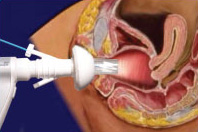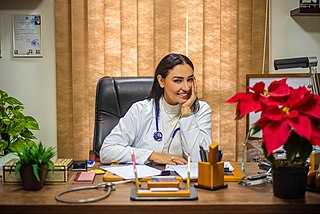
A Chinese medical doll, also known as a diagnostic doll or "Doctor's lady", is a type of small sculpture of a female figure, historically used in China and parts of Asia as a diagnostic tool.

A Chinese medical doll, also known as a diagnostic doll or "Doctor's lady", is a type of small sculpture of a female figure, historically used in China and parts of Asia as a diagnostic tool.
In China, the dolls have been recorded as early as the 15th century Ming Dynasty, [1] with some still seeing use into the 1950s. [2] During this time, the prevailing attitudes of feminine modesty made it improper for a woman to gesture or describe parts of her own body. Because of this, when seeing a physician, a woman would indicate medical issues by referring instead to the respective anatomy of the doll. [2] [3] [4] [1]
The dolls depicted a nude woman, lying either on her side or back, positioned in such a way that a user would be able to point to every part of the body. [5] They are typically made of ivory or jade and are uncolored, often with an accompanying pedestal shaped like a couch or bed made of ivory [5] or wood. [2] It is not uncommon, especially on older figures, for the woman to be depicted with small pointed feet, representative of the practice of foot binding which was common in China until the 20th century. [5] [6] The figures typically measure anywhere from 75 to 150 mm (3.0 to 5.9 in) in length. [5] In addition to the functional form, many of the dolls depict aesthetic additions including jewelry, fans, and shoes, and some feature colored hair, typically painted with lacquer. [2] [6]
Visits to physicians by women during this time were restricted by attitudes of modesty and contact between genders, as physicians were almost always men. Visits by women to doctors were often conducted with a screen made of bamboo between the two, with the woman only reaching her hands out from behind the screen to interact with the medical doll. [1] These dolls were typically owned by the physicians themselves; [4] however, upper-class clientele would sometimes have their own customized dolls, and some would even send a servant in place of themselves to describe their condition. [2] [6] [7]

Medicine is the science and practice of caring for a patient, managing the diagnosis, prognosis, prevention, treatment, palliation of their injury or disease, and promoting their health. Medicine encompasses a variety of health care practices evolved to maintain and restore health by the prevention and treatment of illness. Contemporary medicine applies biomedical sciences, biomedical research, genetics, and medical technology to diagnose, treat, and prevent injury and disease, typically through pharmaceuticals or surgery, but also through therapies as diverse as psychotherapy, external splints and traction, medical devices, biologics, and ionizing radiation, amongst others.

Neurology is the branch of medicine dealing with the diagnosis and treatment of all categories of conditions and disease involving the nervous system, which comprises the brain, the spinal cord and the peripheral nerves. Neurological practice relies heavily on the field of neuroscience, the scientific study of the nervous system.

A physician, medical practitioner, medical doctor, or simply doctor is a health professional who practices medicine, which is concerned with promoting, maintaining or restoring health through the study, diagnosis, prognosis and treatment of disease, injury, and other physical and mental impairments. Physicians may focus their practice on certain disease categories, types of patients, and methods of treatment—known as specialities—or they may assume responsibility for the provision of continuing and comprehensive medical care to individuals, families, and communities—known as general practice. Medical practice properly requires both a detailed knowledge of the academic disciplines, such as anatomy and physiology, underlying diseases and their treatment—the science of medicine—and also a decent competence in its applied practice—the art or craft of medicine.
Obstetrics is the field of study concentrated on pregnancy, childbirth and the postpartum period. As a medical specialty, obstetrics is combined with gynecology under the discipline known as obstetrics and gynecology (OB/GYN), which is a surgical field.

Gynaecology or gynecology is the area of medicine that involves the treatment of women's diseases, especially those of the reproductive organs. It is often paired with the field of obstetrics, forming the combined area of obstetrics and gynaecology (OB-GYN).
Internal medicine, also known as general internal medicine in Commonwealth nations, is a medical specialty for medical doctors focused on the prevention, diagnosis, and treatment of internal diseases in adults. Medical practitioners of internal medicine are referred to as internists, or physicians in Commonwealth nations. Internists possess specialized skills in managing patients with undifferentiated or multi-system disease processes. They provide care to both hospitalized (inpatient) and ambulatory (outpatient) patients and often contribute significantly to teaching and research. Internists are qualified physicians who have undergone postgraduate training in internal medicine, and should not be confused with "interns", a term commonly used for a medical doctor who has obtained a medical degree but does not yet have a license to practice medicine unsupervised.

Marie Elisabeth Zakrzewska was a Polish-American physician who made her name as a pioneering female doctor in the United States. As a Berlin native, she found great interest in medicine after assisting her mother, who worked as a midwife. Best known for the establishment of the New England Hospital for Women and Children, she opened doors to many women who were interested in the medical field and provided them with hands-on learning opportunities. Within the New England Hospital, she established the first general training school for nurses in America. Her drive and perseverance made the idea of women in medicine less daunting. She also initiated the creation of the first sand gardens for children in America.

Apothecary is an archaic English term for a medical professional who formulates and dispenses materia medica (medicine) to physicians, surgeons and patients. The modern terms 'pharmacist' and 'chemist' have taken over this role.

Elizabeth Blackwell was a British and American physician, notable as the first woman to earn a medical degree in the United States, and the first woman on the Medical Register of the General Medical Council for the United Kingdom. Blackwell played an important role in both the United States and the United Kingdom as a social reformer, and was a pioneer in promoting education for women in medicine. Her contributions remain celebrated with the Elizabeth Blackwell Medal, awarded annually to a woman who has made a significant contribution to the promotion of women in medicine.

Byzantine medicine encompasses the common medical practices of the Byzantine Empire from c. 400 AD to 1453 AD. Byzantine medicine was notable for building upon the knowledge base developed by its Greco-Roman predecessors. In preserving medical practices from antiquity, Byzantine medicine influenced Islamic medicine and fostered the Western rebirth of medicine during the Renaissance.

Medicine in ancient Rome was highly influenced by ancient Greek medicine, but also developed new practices through knowledge of the Hippocratic Corpus combined with use of the treatment of diet, regimen, along with surgical procedures. This was most notably seen through the works of two of the prominent Greek physicians, Dioscorides and Galen, who practiced medicine and recorded their discoveries. This is contrary to two other physicians like Soranus of Ephesus and Asclepiades of Bithynia, who practiced medicine both in outside territories and in ancient Roman territory, subsequently. Dioscorides was a Roman army physician, Soranus was a representative for the Methodic school of medicine, Galen performed public demonstrations, and Asclepiades was a leading Roman physician. These four physicians all had knowledge of medicine, ailments, and treatments that were healing, long lasting and influential to human history.
Tan Yunxian was a Chinese physician during the Ming dynasty in China.

The presence of women in medicine, particularly in the practicing fields of surgery and as physicians, has been traced to the earliest of history. Women have historically had lower participation levels in medical fields compared to men with occupancy rates varying by race, socioeconomic status, and geography.
Medical fiction is fiction whose events center upon a hospital, an ambulance staff, or any medical environment. It is highly prevalent on television, especially as medical dramas, as well as in novels.

Medical diagnosis is the process of determining which disease or condition explains a person's symptoms and signs. It is most often referred to as a diagnosis with the medical context being implicit. The information required for a diagnosis is typically collected from a history and physical examination of the person seeking medical care. Often, one or more diagnostic procedures, such as medical tests, are also done during the process. Sometimes the posthumous diagnosis is considered a kind of medical diagnosis.

A medical bag is a portable bag used by a physician or other medical professional to transport medical supplies and medicine.
Marilyn Hughes Gaston is a physician and researcher. She was the first black woman to direct the Bureau of Primary Health Care in the U.S. Health Resources and Services Administration. She is most famous for her work studying sickle cell disease (SCD).
Joann G. Elmore is a professor of medicine at the David Geffen School of Medicine, professor of Health Policy and Management at the UCLA Fielding School of Public Health Director of the UCLA National Clinician Scholars Program, the endowed chair in Health Care Delivery for The Rosalind and Arthur Gilbert Foundation, and a practicing physician . She publishes studies on diagnostic accuracy of cancer screening and medical tests in addition to AI/machine learning, using computer-aided tools to aid in the early detection process of high-risk cancers Previously, she held faculty and leadership positions at the University of Washington, Fred Hutchinson Research Center, Group Health Research Institute, Yale University and was the Associate Director and member of the National Advisory Committee for the Robert Wood Johnson Clinical Scholars Program at Yale and University of Washington. Elmore received her medical degree from the Stanford University School of Medicine, residency training in internal medicine at Yale-New Haven Hospital, with advanced epidemiology training from the Yale School of Epidemiology and Public Health and the RWJF Clinical Scholars Program. In addition, she was a RWJF generalist physician faculty scholar. Elmore is board certified in internal medicine and serves on many national and international committees. She is Editor in Chief for Adult Primary Care at Up-To-Date and enjoys seeing patients as a primary care internist and teaching clinical medicine to students and residents.
Elizabeth Margaret Forbes was a Canadian radiologist. Forbes was the Chief of Radiology at Toronto's Women's College Hospital (WCH) from 1955 to 1975. She is remembered for co-authoring “one of the first Canadian papers on mammography” with WCH's Henrietta Banting.

Amanda E. Taylor Norris was an American physician, the first woman physician in the state of Maryland. After graduating from the Woman's Medical College of Pennsylvania in 1880, she worked in private practice in the Baltimore area, spending nearly two decades teaching at coeducational and women's medical schools there.